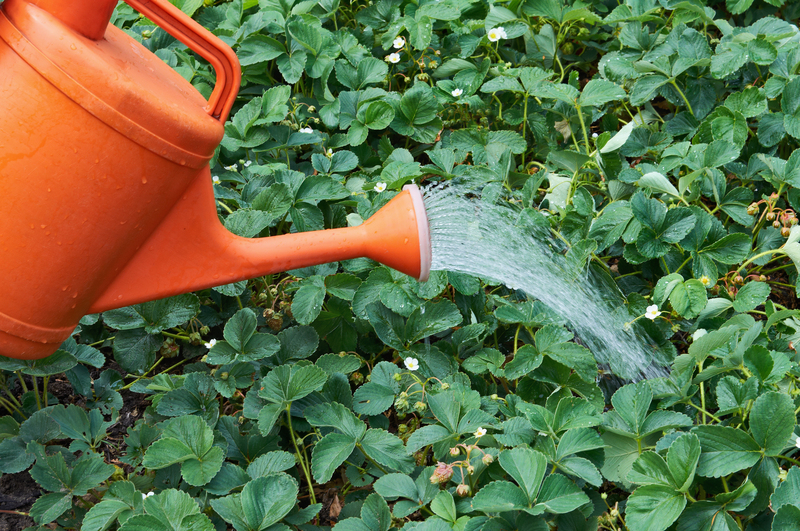Innovative Tips for Herb Gardens
Posted on 05/09/2025
Innovative Tips for Herb Gardens: Elevate Your Green Space
Growing a herb garden can be a rewarding and practical addition to any home, offering fresh flavors for your kitchen, vibrant aromas, and a visually appealing landscape. Whether you're an experienced gardener or a beginner yearning for fresh herbs at your fingertips, exploring innovative tips for herb gardens can help you unlock new levels of productivity, creativity, and sustainability. In this comprehensive guide, discover the freshest ideas, techniques, and inspiration to nurture a thriving and unique herb garden.

Why Focus on Innovative Herb Garden Techniques?
Traditional herb gardens are wonderful, but by introducing unique methods and designs, you can make the most out of limited space, improve herb health, and even add a contemporary flair to your home or yard. Let's dive into creative approaches, clever problem-solving, and the secrets to keeping your garden lush all year long.
Choosing the Right Location: Think Beyond the Obvious
- Maximize Sunlight: Most culinary herbs need at least 6-8 hours of sunlight. Consider windowsills, balconies, rooftops, or vertical spaces for urban gardening.
- Creative Containers: Use repurposed items like old teacups, shoe organizers, or tin cans as planters for a quirky and eco-friendly herb garden.
- Mobile Gardens: Design movable herb planters with wheels to follow the sun or bring herbs indoors during harsh weather.
Underutilized Spaces: Vertical Herb Gardens
Vertical gardening is a true innovation for herb cultivation in small spaces. Hang wall-mounted pockets, install tiered shelves, or make a living wall with hydroponic planters. Not only do these systems save space, but they also become striking green features in your home.
- Choose trailing herbs like oregano or thyme for higher pockets.
- Reserve lower shelves for bushier or harder-to-reach varieties such as parsley.
Building a Self-Watering Herb Garden System
Automatic or self-watering systems are a game-changer for busy gardeners and anyone traveling frequently. Construct a DIY self-watering system with recycled plastic bottles, glass globes, or advanced drip irrigation kits. These help maintain optimal soil moisture--ensuring herbs thrive without daily attention.
- DIY Globe Waterers: Fill glass bulbs with water and insert them upside down in the soil to gradually feed the plants.
- Capillary Mats: Place pots atop absorbent mats that wick water upward for consistent hydration.
- Drip Kits: Set timers for automated watering to minimize water waste and ensure steady growth.
Innovative Soil and Fertilizer Choices
Go Organic: Composting Kitchen Scraps
Introduce a small compost bin or worm farm to your kitchen routine. Vermicomposting breaks down food waste into rich nutrients that supercharge your herb garden's productivity. Simply add composted fertilizer to your beds or pots every few weeks.
- Eggshells: Crushed eggshells provide calcium, preventing blossom end rot in herbs like tomatoes and basil.
- Coffee Grounds: Used grounds enrich the soil with nitrogen, keeping leafy herbs lush and green.
- Banana Peels: Place chopped peels in the soil to slowly release potassium and magnesium.
Try Soil Amendments and Mulching
Incorporate soil conditioners such as perlite, coconut coir, or vermiculite for improved drainage and moisture retention. For an added innovation, use colored glass mulch or decorative stones as a unique visual accent and weed barrier.
Companion Planting: Nature's Innovation
Companion planting is an ancient but continually evolving strategy--pairing herbs to boost growth, improve flavor, and repel pests naturally. With new research and creative garden layouts, consider these dynamic partnerships:
- Basil and Tomatoes: Enhances each other's growth and flavor while deterring insects.
- Mints and Cabbages: Mint repels cabbage moths and should be contained to avoid overtaking.
- Chives and Carrots: Reduces pest infestations and promotes vigorous root development.
Modern Herb Garden Installations and Technology
Hydroponics and Indoor Smart Gardens
If you're looking to harness cutting-edge techniques, modern hydroponic systems are perfect for year-round herb production--no soil or garden plot required. Install a countertop smart garden with LED lights and automated watering for effortless fresh herbs.
- Try starter kits from brands like AeroGarden or Click & Grow for plug-and-play simplicity.
- Or build your own hydroponic tower using PVC pipes or recycled containers for a cost-effective solution.
Using Technology for Smarter Gardening
Leverage modern gadgets like soil moisture meters, Bluetooth planters, gardening apps, and automated climate controls. With these tech-savvy tools, you'll ensure optimal growing conditions even from afar.
- Set reminders for harvesting and watering via smartphone apps.
- Connect sensors to smart home systems to monitor temperature and humidity for delicate herbs.
Creative Garden Design Ideas for a Stylish Herb Space
Herb Spirals: Beautiful and Efficient
One of the most artistic and functional herb garden innovations is the herb spiral. This vertical, spiraled bed maximizes space and creates multiple microclimates for different herbs. Plant sun-loving species on the upper levels, shade-lovers at the base, and enjoy a living sculpture!
- Construct spirals from stones, bricks, or logs for natural beauty.
- Mimic a Mediterranean climate at the top and a cooler, moister base below.
Multi-Use Spaces: Integrating Herbs into Other Garden Plans
Don't limit herbs to stand-alone gardens. Interplant them among flowers, vegetables, or even grown as edgings along pathways. Some innovative placement ideas include:
- Bordering walkways with thyme or marjoram for a fragrant stroll.
- Interplanting basil or dill with tomatoes in veggie beds for a lush and productive mix.
- Window boxes filled with a medley of edible and ornamental herbs for a burst of color and taste.
Cutting-Edge Maintenance and Harvesting Tips
Succession Planting for Year-Round Herbs
To maintain a steady supply of fresh herbs, implement succession planting. Sow seeds or young plants every few weeks to replace older herbs and keep your garden producing continually.
- Stagger cilantro seeds to harvest tender leaves as needed.
- Rotate fast-growing microgreens like basil or cress for constant access to ultra-fresh greens.
Selective Pruning and Pinching
Regular pruning is key to healthy, bushy herbs. Innovative gardeners use sharp scissors to snip just above a leaf node, stimulating new growth and preventing legginess.
- Pinch: Early pinching removes flower buds from basil, mint, and parsley, focusing energy on flavorful leaves.
- Harvest in the Morning: Pick herbs before midday for peak oils and intense flavors.
Pest and Disease Management without Chemicals
Natural Repellents and Barriers
Practice environmentally friendly pest control by using innovations like garlic spray, neem oil, or diatomaceous earth. Companion planting with pest-repelling herbs offers a safe and effective approach.
- Place copper tape around containers to deter slugs.
- Grow chives and garlic near susceptible herbs to minimize aphids and mites.
- Handpick caterpillars and beetles for organic control.
Healthy-Air Movement and Drainage
Promote strong air circulation in dense plantings to prevent mold and fungal disease. Use raised beds or pots that drain easily--soggy soil invites root rot and fungus gnats.
Preserving and Enjoying Your Homegrown Herbs
Innovative Drying and Storage Methods
Extend your harvest by air-drying, dehydrating, or freezing herbs for future use. Get creative:
- Hang bunches upsidedown in a paper bag to shield from dust and preserve flavor.
- Chop and freeze delicate leaves in ice cube trays with olive oil for instant flavor boosts.
- Infuse vinegars, oils, or syrups with fresh-cut herbs for unique gourmet condiments.
Creative Culinary Uses for Homegrown Herbs
Experiment with herb butters, teas, savory salts, or even homemade herbal soaps. Fresh, innovative recipes make the most of your garden's bounty and add a signature twist to your daily cooking.

Eco-Friendly and Sustainable Practices
Water Conservation Techniques
Install rain barrels or reuse graywater from kitchens (without detergent) to irrigate your herb garden. Mulch with straw or leaves to prevent evaporation and reduce the need for frequent watering.
- Opt for drought-tolerant herbs like rosemary and sage in arid climates.
- Group plants by water needs to avoid overusing resources.
Native and Pollinator-Friendly Herb Selection
Choose local or drought-adapted herb varieties to support native pollinators, reduce maintenance, and increase overall biodiversity. Popular choices include lavender, bee balm, and lemon balm.
Conclusion: Unleash Creativity With Innovative Herb Garden Ideas
A successful herb garden isn't just about growing plants--it's about embracing innovative herb gardening tips, experimenting with design, technology, and care, and enjoying the beautiful intersection of nature and creativity. By implementing these clever strategies for herb garden success, you'll cultivate a thriving, sustainable, and uniquely personalized green haven.
Plant, experiment, and savor your homegrown flavors--your journey to a bountiful innovative herb garden awaits!
- Explore more: Read our guides on herb garden design and organic gardening tips for deeper insights.

